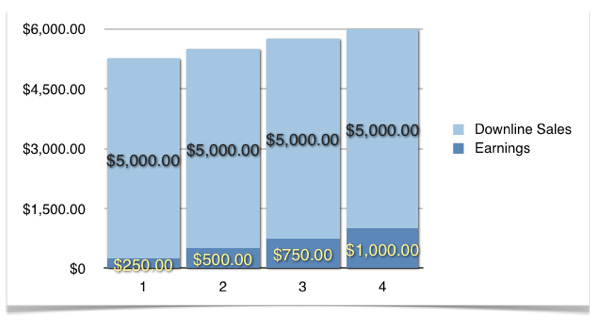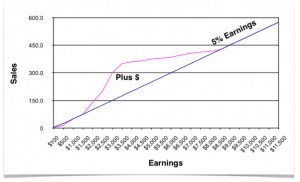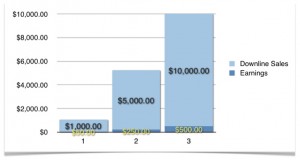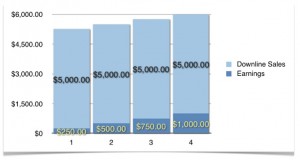SHARE
Bringing Compensation Plans Into Perspective Part 2

5% Plus Theory
The 5% Plus Curve observed in network marketing industry commissions provides a standard for network marketing companies to allocate commission money. The 5% Plus Theory says, in order for a compensation plan to be viable: 1) each upline distributor that receives commissions must receive at least 5%, and 2) a company must pay those upline distributors critical to its growth and stability at a higher percentage. The compensation plans that have survived have done so by implementing this theory.
There’s a problem with paying only the standard 5% because if the downline sales for a distributor are $10,000 and you give that individual 5%, his/her earnings are only going to be $500. Is this the appropriate amount for a distributor to earn on $10,000 of sales? If somebody else is making those sales other than that individual, then maybe it’s appropriate. But, if he/she is personally making those sales alone, he/she will soon bail and work at Wal-Mart because the MLM earnings per hour are just too low!
Applying the 5% Plus Theory, you pay additional money to the upline distributor who is responsible for those sales. So, the challenge is to create a segment of the downline that can make a higher percentage. These are the people you really want to “incentivize.” The vehicle to accomplish this is hybridization of the compensation plan—adding on additional commission types, i.e., a fast start program.
Abiding by the 5% Plus Theory enables your distributors to solidly count on:
• If I build a downline, I will have some control over my destiny.
• If I build my downline properly, I will get paid on the majority of all of my downline sales.
. Figure 2: 5% Standard Commission.
Plan Payout at Maturity.
Be sure you know the true long-term cost of your compensation plan before you announce it. Your estimate of the percent of sales you will pay out should be done at maturity—for many companies, about four to eight years from launch. It takes experience and a good analytical approach to accurately project plan payout at maturity. Some companies may need to call upon a competent consultant who has done this before for help.
Qualifications and Rank Advancements
Distributors want to be able to depend on a clearly defined set of rules that tell them what they have to do to be paid each month and to advance in rank. The company’s compensation plan will almost certainly have to include two categories of rules: 1) commission qualifications rules, and 2) rank advancement rules. A company has to attribute qualifications and rank advancement to the act of work. Basically, a company builds its qualification rules to set the distributors on the path it wants them to follow, and then puts in a system of commissions that rewards them for following that path.
This is where the issue of having ranks and lots of commission types creates a challenge for a company. The more ranks a company has, the more rules are required for distributors to advance from rank to rank and to qualify to earn each of the commissions associated with those ranks. This means the compensation plan description becomes more complex. The more complex the compensation plan becomes: 1) the harder it is to explain, and the more time you need to explain it, 2) the more confused people are, and 3) the more distributor service people the company must employ.
Companies can help alleviate this situation by having a consistent method of advancing from rank to rank. The advancement rules should set up a logical, consistent manner for: 1) calculating commission payout for each rank, 2) achieving a rank in the first place, and 3) maintaining qualifications. In general, a company should make the rules as simple as is feasible to achieve the desired results.
In most companies, the distributors advance in rank by building their organizations and increasing their downline sales volume. A company always needs to keep the top rank in mind as it defines the rules for the other ranks.
Another thing to remember is that once distributors reach the highest rank, it’s tempting for them to quit building their organization and “retire.” When a company defines the top rank, it needs to make sure that when people do achieve that rank, their earnings are in line with the respect the company wants the rank to command. For example, if 4-Star Diamond is the top rank, and some distributors at that rank are earning only $2,000 a month, it won’t command much respect. This is especially problematic if some 4-Star Diamonds are earning $2,000 a month and others $100,000 a month.
Once a company decides what qualifications to use, it’s important to build consistency as a distributor moves from rank to rank. A distributor shouldn’t have to build one way to become a sales leader and then change methods to get to the next rank. A company shouldn’t, for example, encourage distributors to build their downline deep, and then switch to having them build their downline wide in order to advance to the top rank.
Once a company decides which qualifiers to use, the next question is, “Over what time period”? Do distributors have to meet the qualification to achieve a rank within a month, several months, or do they have forever to achieve it?
Caution: Make sure your compensation plan isn’t rewarding non-producers. Examine what happens with your plan if distributors fail to produce. Do they continue to receive compensation at the level of their performance? If not, you’re rewarding nonperformance at the expense of performers. What one man receives without working, another man works for without receiving.
Five Steps of Compensation Plan Design
As with any complex question, it is best to break designing a compensation plan down into small steps and tackle them one at a time. The five steps of compensation plan design include:
1. Establish your company’s mission, product and service strategy, and intellectual distribution strategy. Intellectual distribution is education. It requires teaching potential consumers what a product does and how it can help them.
2. Decide what percentage of your product price you want to pay out in commissions.
3. Divide your commission payout between sales commissions and sales management commissions.
4. Decide which commission and qualification methods to use.
5. Create an ongoing series of incentives that fit with the compensation plan you created.
If this sounds like a great oversimplification, it is. In fact, designing a compensation plan is like playing chess against a grand master—unfortunately, some people treat it like playing tic-tac-toe.
Understanding the Game Board
In a way, implementing a compensation plan is like learning to play chess. It seems easy at first. All you have to do is learn what each piece can do. The bishop can move diagonally. The knight can jump over another piece and then scoot over a square. The queen can move in any direction, etc. But, then when you start playing an actual game, you find out that you have to think about a whole lot more than the basic moves of each piece. Are you overlooking an opportunity to capture your opponent’s queen? What is likely to happen three moves from now, or six moves from now? Is your king open to checkmate?
you may also like
Essential Software Customizations for MLM, Direct Selling, and Affiliate E-commerce
Navigating the changing landscape of e-commerce, particularly within MLM, direct selling, and affiliate marketing channels, requires more…
How to Ensure Your Compensation Plan and Software Work Well Together
Peanut butter and jelly. Milk and cookies. Batman and Robin. Everybody knows these famous pairings work well…
Podcast 53: Advantages Using an Interim VP of Sales for Direct Selling Companies
Today we welcome a returning guest of this podcast: Jeff Jordan. Jeff has also written articles for…
compensation consulting for mlm companies
We offer data-driven compensation plan design & analysis
MLM.com Newsletter
Get our e-mail newsletter, with MLM.com articles & online exclusives, delivered to your inbox each week.






